|
|
|
|
Contact:
Alcohol Stove Use Basics
After you have read Zen and the Art of the Alcohol Stove and now about the many stove designs out there, you may have some basic technical questions about how to use and get the most out of your stove. If you are wondering about the mechanics and science involving stoves then visit How Stoves Work.
Each of the basic designs vary a bit in how they work. Please read through the instruction before you set up your stove for the first time and make sure that you set up your first experimental fire-up in an area not prone to combustion and that you have something to put out any flames should something go wrong.
Open Flame, Chimney and Open Jet Alcohol Stoves
Pour in about 0.5 to 1oz of fuel
Light
Set up pot stand
Set pot on stand and wait for water to boil.
Low Pressure SideBurner Alcohol Stoves
Pour in about 0.5 to 1oz of fuel (don't fill so much that fuel leaks out the holes when your stove heats up)
Light
hold pot 2.5 cm/1 inch above flame (so as to not waste that heat and to reflect some back down at the stove) until flames get good and hot (less than a minute under most circumstances).
Slowly lower your pot centered on your stove. If the flame dies, you didn't allow stove to heat up enough - try again and wait a little bit longer for stove to heat up.
NOTE -
Not placing pot on stove will result in a much greater fuel consumption rate and wasted fuel.
Consider using a primer pan to decrease the amount of fuel needed to preheat your stove and to make your life easier (no need to suspend pot over stove).
Hybrid Side Burner Jet Alcohol Stoves
Pour in about 0.5 to 1oz of fuel (don't fill so much that fuel leaks out the holes when your stove heats up)
Light
hold pot 2.5 cm/1 inch above flame (so as to not waste that heat and to reflect some back down at the stove) until flames come out the side jets of your stove. Let the stove heat up just a bit (till flames get a little high), but not too much.
Place pot centered on stove. If the flame dies, you didn't allow stove to heat up enough - try again and wait a little bit longer for stove to heat up.
NOTE -
Not placing pot on stove will result in a much greater fuel consumption rate, waste and over heating of your stove.
Consider using a primer pan to decrease the amount of fuel needed to preheat your stove and to make your life easier (no need to suspend pot over stove).
Pressurized Jet Alcohol Stove
Remove screw from stove if applicable.
Add about 0.5 to 1oz of alcohol to stove.
Replace screw (or other sealing device).
NOTE - if you don't replace the screw, there is a chance your stove will explode when primed if vapors inside the stove are ignited from the open filler hole.
Add a small amount of fuel to primer plate by tilting your stove over until it leaks on your pan or add some from a bottle or syringe (if your jets don't fire up after priming - you didn't add enough, if you have a fireball with flames shooting out 6 inches for an extended period- you added too much).
Set the stove on the primer plate.
Light the primer plate.
Set up pot stand if applicable.
Set pot on stand (or on stove if a SideBurner design) and wait for water to boil.
NOTE -
setting up the stand and pot immediately after lighting may be necessary to keep stove lit while it is heating up to the optimal burn temperature.
Refer to Don Johnson's video of lighting his pressurized stove.
Lighters
You'll need a fire starter if you want to use your stove and have many options.
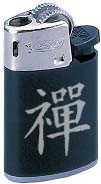
Matches and disposable lighters generally work fine for lighting your stove but aren't waterproof.
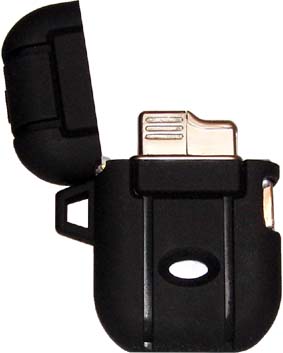
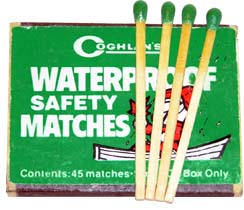
Commercial weatherproof matches and lighters are nice but can start adding to your weight and still may not work after getting wet.
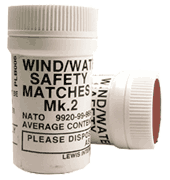
The military MK 2 Wind/Water Safety Matches (aka lifeboat matches) are actually waterproof and are the heat (pun intended). These are overkill.
A Spark-Lite is an ultralightweight option (0.19 oz / 5.4 g) and waterproof. They come in OD green and orange. Depending on what temperatures you are working with and your particular stove setup - this may or may not be the fire starter for you.
Note - cold temperatures, low quality fire starter knockoffs, and stoves with deep fuel chambers will make it more challenging for these little sparkers to work for your setup.

Spark-Lite
These work best if you are able to use the sparker just a few millimeters above the fuel you are trying to ignite. They are less affective at lighting a stove that has a fuel line deep inside an inner priming chamber.
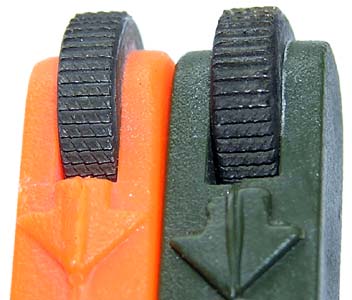
Difference in grinding wheel quality
It's important to note that not all Spark-Lites are created equal. If you look very closely at the grinding wheels on the two sparkers shown above, you might be able to notice that the orange sparker's grinding wheel has higher quality cut teeth, allowing it to throw out enough heat to easily start a newspaper page on fire, while the green sparker to the right is not much better than sparker found on a disposable cigarette lighter.
Pot Stand
If you have a stove that doesn't have a built in pot stand, you will need one to support your pot over your stove.
See Pot Stands for more information.
Wind Screen
This will save a considerable amount of heat and thus decrease fuel consumption and boil time.
See Build a Wind Screen for more information.
Ground Reflector
A piece of heavy duty aluminum foil about the diameter of your windscreen or a bit wider than your stove will help you heat the pot and not the ground.
Cooking in Wet Weather
Getting water in your stove and fuel should be avoided as small amounts of water will severely decrease the heat output of your stove or cause it to fail completely.
Using a primer pan to heat your stove may help out dramatically, especially if you are using a sideburner stove.
If you spend a lot of time in the wet, you may want to build a stove with larger jets (push pin size, #57 or larger) or use an open flame stove.
If you can't get a sideburner stove to work as designed, use rocks for a pot stand and set your pot an inch above your stove and use your stove as an open flame stove.
You may need to use a good Spark-Lite or high output lighter if you will be very wet, as waterproof matches and regular lighters may not function.
Cooking in Cold Weather
If you are cooking on snow, you may need a platform for your stove. This will keep the snow and ice from over cooling you stove and prevent it from sinking into the snow as it heat up.
Store your fuel and water bottles inside your sleeping bag at night to keep their temperature up, or from freezing.
While hiking - keep the fuel and water bottles buried inside your pack rather than storing them in an outside pocket or keep them inside your jacket.
Carry a tealight or other candle and before filling the stove with fuel, warm the body of the stove from beneath for a minute or so until it feels warm, but not too hot to hold.
Decreasing Heat Output
There are many reasons that you might want to decrease heat output - to simmer, prevent burning your meal, prevent damage to a delicate stove design, etc.
Restricting air coming in to the stove with foil or other device should decrease the amount of fuel burned.
Adding small amounts of water to fuel may decrease burn temperature. Adding too much will eventually extinguish the flame. How much water you can add depends on your stove design and fuel you are using.
Pot Cozy
Can save a considerable amount of fuel compared to simmering.
Allow for field cooking foods such as rice and beans when simmering isn't an option (stove design, fuel on hand).
Keeps food warm longer.
See Build a Pot Cozy for more information.
Screw for Pressurized Stoves
NOTE - if you don't replace the screw prior to lighting your stove, there is a chance your stove will explode when primed if vapors inside the stove are ignited from the open filler hole. It will most likely only just pop - with burning fuel thrown everywhere.
Pack an extra one.
If you lose your screw, you might get away with using a coin or small stone to cover the fuel port.
Stainless steel or titanium screws work well and should last forever, but aluminum or brass can be used. Avoid regular steel which will rust.

Screw may be painted with high temperature paint to help it stand out and make it easier to find.
If you want to get fancy, you could make a self closing fuel port or chain your screw to your stove. See Pressurized Jet Stove Construction for more information.
FAQ/Common Questions and Answers
I made a _______ stove as per your instructions but it doesn't seem to work. What do I do?
The first thing to check is your fuel. If you are using rubbing alcohol or anything with isopropanol, your stove will not perform as well as it should or at all. Try using denatured alcohol or HEET in the yellow container.
I made an open jet stove just like the Pepsi G and the only thing that burns is the center part of the stove.
The jets can be very difficult to see and are almost invisible in the daylight or a well lit room. Place your stove on something like a stovetop and light your stove. Wait a minute or so and look at your burning stove from the side with the lights turned off. Do you see jets now?
If your jets still don't light, check to see if your inner wall is loose. If it is (you can move it easily), the outer chamber of your stove will not developed sufficient pressure for the jets to work. You can try to shove some JB Weld or high temperature silicone in the in the upper rim of your stove where the inner wall meets the upper part of the stove, or just build another stove. If you are using the smaller sidewall template, make sure that your can section being overlapped has been shortened appropriately (20-25mmish vs 30mm). When you build a stove with an inner wall make sure that everything is pressed snug together and place a heavy book on your stove to keep it that way while your sealer sets overnight.
Is it safe to store alcohol in a _______ ?
Alcohol doesn't react with most common metals (tin, steel and aluminum) or plastics used for containers. Some fuel containers have a protective coating that your alcohol may remove, leaving your container unprotected from more reactive fuels or more prone to rust. See Fuel Storage for more information.
I love your site and would like to purchase a stove from you.
Sorry, this site if for informational purposes only and is not set up to sell stoves. It is pretty easy to build a stove and recommend that you give it a shot. If you still feel that you would rather purchase a stove, there are several internet sites that would love to take your money. See the commercial stove section of Links for places to spend your money.
I have an Optimus stove and the _______ broke. What do I do?
I'm not a Optimus expert and would need to look at the stove in person to tinker with it. You might try one of the other sites dedicated to kero stoving listed in Links or a forum such as Classic Camp Stoves Forum or The Stove Collector's Discussion Board. Several of these sites have forums trafficked by stovers that would be able to better answer your questions.
I have a stove site and would like to get added to your Links page. What do I do.
Send me a link to your page and I'll add it if it has something to do with stoving. Thanks.
What's the best fuel to use in my stove?
That depends on what you mean by best. The best running fuel for your stove is either going to be a good quality denatured alcohol or yellow HEET (methanol). Rubbing alcohol doesn't work well in any stove but is the cheapest to use.
I built a Supercat stove and I can't get it to work with the pot on it. I used a small tuna can and punched holes in the side similar to those in the picture.
Are you using an aluminum can or a steel can? If you are not sure, take a magnet to your can. If the magnet clings to your can, it is made of steel. A steel stove requires a great amount of heat for it to operate than an aluminum stove of this design. Go find an aluminum can and try again. Just remember to take your magnet with you when you head out can hunting.
How can I tell if the stove is running if in direct sunlight?
Can you hear it running? If not you can place a pine needle, dry leaf, grass or piece of paper where there should be flames. If they burn, your stove is still running. Some hikers test with their fingers, but this isn't recommended for obvious reasons, especial in the cold where you may have decrease sensation in your hands.
Can I use white gas in an alcohol stove?
White gas burns much hotter and will burn out of control in a stove designed for alcohol. This type of fuel also has the potential for exploding.
I want to run a stove with biodiesel. Got any ideas?
I have lots of ideas. Some of the commercial multifuel stoves can burn biodiesel or corn oil to a point but may need to be mixed with a little alcohol or kerosene. What you will want to look for in a stove is a large diameter generator tube and has a lot of surface area in the flame area of the stove and small diameter jets. there is some information on biodiesel and biodiesel in stoves in the Links section.
Do you know anything about adding water to alcohol in stoves?
That can serve one of two purposes. First off, it can lower stove temperatures to allow for continuous operation of very delicately constructed stove designs such as the original aluminum cyclone stoves.
Second, water in the proper proportions can be added with certain fuels to increase efficiency and decrease emissions. Trangia recommends: "To avoid sooting, dilute the fuel with 10 or max. 15% water."
There is a lot of research going into determining how adding water to the combustion process to reduce emissions. Water decreases oil viscosity (which enhances transport), adds stability and lowers combustion temperatures. If you add water to diesel (such as in PuriNOx), it theoretically lowers the peak combustion temperature and and produces less NOx when used in a diesel engine.
Water and alcohol have long been used in aircraft engines to cool air being pulled in (making it denser) and for reducing detonation.
What's the best alcohol stove to use and which do you like best?
That's a very difficult question and comes down to several factor with the most important being preference.
If you want simplicity - an empty tuna can for your stove and three rocks found on the trail for a pot stand.
If you want simple to use but still fancy with jets - a top burner open jet stove and you choice of windscreen pot stand
If you want good output, dependability and simmering - a Cat Can Stove with a simmer ring and simmer lid and a nice pot stand (rolled up stainless wire mesh)
If you want dependability in a simple all in one setup - a mini chimney or Supercat (depending on pot size)
A gift for someone - a sideburner jet stove since it is an all in one system (don't need a pot stand or primer dish) and the pop or beer can sides make for a very interesting eye-catching presentation.
Ultra-lightweight system - HOI Heineken can-pot/tea light cup stove (the beer can pot may be substituted with a large Sterno/Canned Heat stove)
High performance - properly set up pressurized jet stove with pot stand separate from windscreen (with high performance, you'll want to observe your stove in action on occasion)
Unique conversation piece - Cyclone stove (bring your chopsticks)
My favorite? I'm a stover and cooking is just an excuse to play with fire. I change stoves often and my choice is dependant on what seems to be more fun at the moment or is a recent experiment that needs some fielding. For a long hike, I would go with a modified Supercat since it works, is simple and is a little tougher than a stove made from pop cans.
I read on the net that beeswax has more BTUs than any other fuel. How can I make a pressurized stove that uses it?
Beeswax and candle waxes do have a lot of potential energy stored in them, but it difficult to harness it through controlled and efficient combustion. First off, most fuels need to be vaporized in order to burn and wax needs a lot of energy to melt and vaporize. Second, beeswax is solid at room temperature and this complicates vaporizing it even more since you can't move it through a generator tube which is something that is commonly used to heat and vaporize liquid fuels. And third, beeswax can actually be pretty dangerous when heated up.
If you burn enough wicks in a metal container to concentrate enough heat for beeswax not on the wick to vaporize, it will continue to feed back heat to itself and burn out of control without the need of a wick. This can be dangerous since you now have an extremely hot liquid and a fireball that can't be blown out. Since so much energy is stored in boiling wax, if you get this on your skin it can cause extreme burns.
Yes, it is possible to build a metal container in which beeswax can be melted and poured into so that it can later be sealed and heated to cause vaporized wax to shoot out a jet, but that would take an enormous amount of priming (which theoretically could be done with beeswax candle). Use of a generator tube would be complicated in that any cooling of liquid wax would cause a clog in the system.
It would seem that making a stove that burns wax in a manner other than using a wick (fiberglass, cotton, grass, woodchips, etc) would not be worth your while, but if you come up with an idea and/or implement it - the outdoors community and myself would love to hear about it!
By the way, Yogi (the bear) has been know to be attracted to the smell of burning beeswax, and use of honey burns is an old time hunting trick for luring in bears.
Do you know of any camping/survival cooking stoves that burn everyday household cooking oil (e.g. olive, sunflower, canola/rapeseed, corn, oils etc.)?
You can try to use cooking oil in the multifuel stove and may get it to work if the fuel, stove and operating conditions are just right. In theory, you may want a stove with a large generator tube and choose a smaller jet to allow for a leaner air/fuel mix for optimal performance since cooking oils are made up of long chain hydrocarbons. You can also build or find a stove or lamp that uses a wick, which will burn just about anything (although, you might want to avoid white gas and gasoline if you value your life).
You may find that you get a lot of soot and may be very disappointed in the performance of vegetable oil, but you can get it to work if you really work at it.
The Optimus site mentions that you can use:
"Good quality colza/rapeseed oil. We canít guarantee that colza/rapeseed oil will work. As with diesel, it is sometimes too crude to vaporize properly."
Several papers on this subject are also published on the web and there is a great deal of interested in creating easy to build stoves that can burn readily available renewable fuels such as vegetable oil.
I'd love to hear about any experiments (successes as well as disappointments) if you decide to try this fuel out.